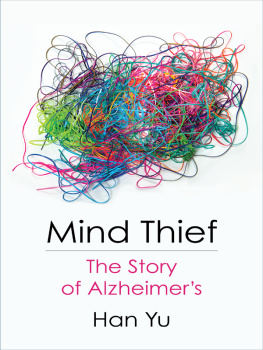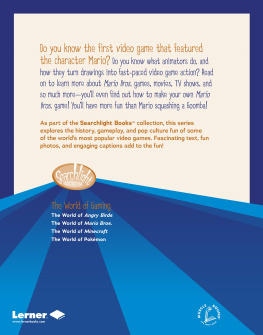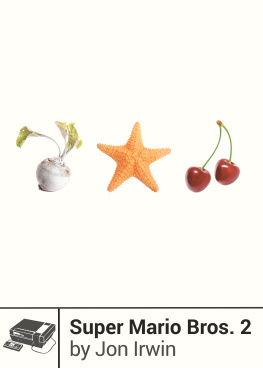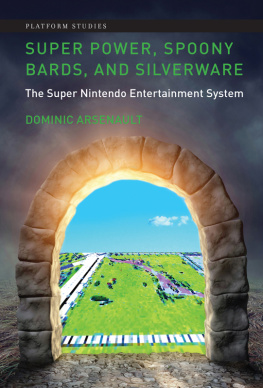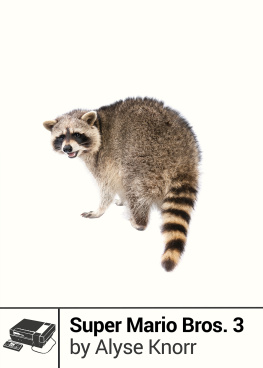For Frances and Caroline
Beginning of the Adventure
When I meet someone for the first time and the topic turns to Spelunky , I describe it as a platform game, like Super Mario Bros., because whether or not you play video games, youve heard of Mario. Mario was the face of the art form during the 1980s and 1990s, when platformers dominated the gaming landscape. Unlike movie genres, which are distinguished by similarities in the themes or narratives, video game genres are generally defined by how the games are played. Platformers, for example, are defined by jumping onto platforms and over obstacles, just as shooters are defined by shooting things and puzzle games are defined by solving puzzles.
Playing Spelunky for the first time, youll notice similarities to other platformers: You run, you jump, you hit enemies. The game starts you off in an abandoned mine, armed with a whip that you can use to dispatch snakes, spiders, bats, and the occasional caveman, as well as ropes and bombs to help you reach otherwise unavailable areas. Since its your first time playing, youll probably die quickly. Maybe you didnt know that the stone block would let loose an arrow when you stepped in front of it, or maybe you misjudged a long jump, sending you into a pit of sharp spikes. Or maybe you lingered too long in the level and a creepy ghost floated onscreen and vaporized you. Or one of your bombs blew up in your face. Oh, well! In Spelunky you only have one life, so if you run out of hearts youll be returned to the lobby room.
Its when you start up your second game that youll notice Spelunky is different from Mario. In Super Mario Bros. , youll always start a new game by taking that familiar stroll to the right, where youll pass by the same four question blocks, the same goomba, and the same short pipe. The levels are unchanging. Each time you play Spelunky , however, youll get a completely different set of sixteen levels. In one run, you may encounter a large pit filled with snakes in the third level, and in the next run you may encounter a sacrificial altar and a bomb shop instead. Occasionally, levels will be dark, forcing you to maneuver carefully by the dim light of flares and glowing scarabs. While each element of the game behaves the same (a snake, for example, will always move back and forth in the same pattern, and an arrow will always do the same amount of damage), the way those elements are arranged is randomly generated at run-time. This randomization is what makes Spelunky stand out among platformers, and its why my full summary of the game is that its a platform game, like Super Mario Bros. , but with randomly-generated levels.
Sometimes Ill describe Spelunky as a platformer thats inspired by roguelikes, although roguelikes are much less well-known. The genre takes its name from a top-down, turn-based fantasy game called Rogue , which was created in 1980 by Michael Toy and Glenn Wichman. Whereas playing a Super Mario or Sonic the Hedgehog game in their heyday was a lesson in designing elegant levels and silky-smooth controls, roguelikes have prided themselves on their randomly-generated dungeons and mechanical complexity. The original Rogue used the ASCII character set for graphics (where an @ might represent the player and a g could be a goblin) and this tradition was carried by roguelikes far into modern times, keeping it a niche genre. Even the popularity of Blizzards Diablo series, which was influenced by roguelikes, didnt do much to raise their profile, since the influence was not widely known. When I started working on Spelunky , roguelikes were only just starting to break into the mainstream consciousness.
It probably doesnt help that what a roguelike is has always been up for debate. At the 2008 Roguelike Developers Conference, a group of roguelike developers attempted to clarify the definition of the genre by creating a list of high and low value factors called the Berlin Interpretation. The Berlin Interpretations high value factors define a roguelike as a turn-based, grid-based, dungeon crawl that features randomized levels and permanent death. The less important low value factors include ASCII graphics, one player character as opposed to a party system, and monsters that share rules and behaviors with players.
When I was working on Spelunky , I focused on just three attributes of roguelikes that to me held the essence of the genre:
- Randomized level generation.
- Permanent death (also known as permadeath), whereby the player has one life and cannot reload their game to take back mistakes.
- A ruleset for physical interactions that is shared by the player, non-player characters (NPCs), and items.
The third attribute is my version of monsters share rules and behaviors with players and it extends not only to monsters but to items as well. In many games, monsters and items are coded separately and handled separately. You might be able to pick up an item and kick a monster, but you couldnt kick an item and pick up a monster. In a roguelike, you should be able to pick up and kick items and monsters, with results that are based on consistent rules. This suggests that the player, the monsters, and the items are treated more like variations on a single type of object than three completely different objects.
Over the years, attempts have been made to add audio and attractive graphics to roguelikes, and to improve their intimidating user interfaces. For example, Mystery Dungeon: Shiren the Wanderer is a Japanese roguelike for the Super Famicom and Nintendo DS that makes traditional roguelike game mechanics more accessible with animated sprites and simplified controls. The latest versions of the canon roguelikes ( ADOM , Angband , Crawl , and NetHack ) now support tile graphics and mouse control as well. But it was a 2006 roguelike/simulation hybrid called Dwarf Fortress that brought the genre into the light, and it did so not by being more accessible, but by being even more complex. Imagine a game that simulates a fantasy world many times larger than the most advanced big budget video game, but rendered completely in characters youd find in a word processor.
Dwarf Fortress has two modes: Adventurer Mode, in which you control a single hero, and Fortress Mode, which tasks you with keeping a community of dwarves alive in a mountain home of your design. This home is just a small part of a world that is procedurally-generated with remarkable detail going back hundreds of years, to the point where you can trace a minor characters lineage back many generations. I read about one world where the history logs revealed that a particular NPCs part-goblin blood was the result of one of his ancestors being kidnapped by goblins during a raid. And one of the cool things about the game is that both Adventurer Mode and Fortress Mode can be played in the same world, so a player could build a fortress in Fortress Mode and then visit that same fortress as an adventurer later (or the ruins of that same fortress, once things inevitably go awry).
Dwarf Fortress made for interesting news because the sheer complexity of what the simulation could carry out seemed nearly matched by its inaccessibility. The game, which is still in constant development, has an air of mystery about it, like its being built by some advanced alien race. Not long after the games first release, the term roguelike began to pop up in mainstream news outlets and on social media. My personal history with the genre extended back to my childhood, so it wasnt new to me, but I also got caught up in the excitement for this previously closed ecosystem being discovered by the outside world.
Puzzle Pieces
The creative mind is like a big pile of jigsaw puzzle pieces. Some pieces were made by other peopleinspirational words of advice, an intriguing screenshot from a game youve never heard of, a haunting melodyand some are gained through life experiences. Some pieces are already connected, either because they came that way or because while you were walking down the street or taking a shower they somehow found each other. Sometimes a single piece is missing, and once that piece is uncovered, two other pieces from different ends of the pile can finally be connected.




